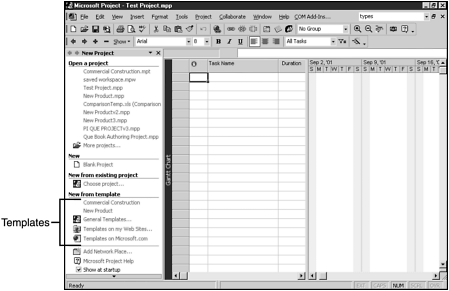Creating and Using Templates
A template is a project file that contains a typical or standard set of tasks or resources that is used as a blueprint or starting point for creating similar new project files. Microsoft Project provides 12 sample templates, but you can create your own templates as well. For example, you might create a template that lists a standard set of tasks that are common to a type of project you perform repeatedly. Likewise, if the same group of people is always involved in your projects, you can create a template that contains the resource information so you won’t have to enter it for each new project file. Each template file has an .mpt extension.
Opening Template Files
When you open a template, you are opening a copy of the file, not the original template. You use this copy as a starting point for a new project.
|
| To open a template file that you or another user has created, choose File, Open or click the Open button on the Standard toolbar. Navigate to the appropriate folder, select the template you want to open, and then choose Open or double-click the filename. (The sample templates included with Microsoft Project are discussed later in this chapter.) |
When you save such a file, the Save As dialog box opens. The project name defaults to the name of the template, but the file type is changed to .mpp, with the exception of GLOBAL.MPT. You can use the default name or supply a different name.
The Global Template: GLOBAL.MPT
When you create a new, blank project document, the new file is based on a default project template, GLOBAL.MPT. The new file inherits all the features of GLOBAL.MPT. All new projects have generic document titles (Project1, Project2, and so on). GLOBAL.MPT is typically stored in the Program FilesMicrosoft OfficeOffice1033 directory or the WindowsApplication DataMicrosoftMS Project1033 directory, depending on the operating system.
NOTE
To designate the language in which Windows and Office are installed, Microsoft uses folders with numerical names. 1033, mentioned above, designates English. If you have a different language version of Windows or Office installed, the folder name is a different number.
Changes made to GLOBAL.MPT affect all new project files. The Organizer is used to make changes in GLOBAL.MPT. (See the “Using the Organizer” and “Troubleshooting” sections later in this chapter for more information about modifying GLOBAL.MPT.)
→ When using Microsoft Project 2002 Professional in an enterprise environment, there is also an enterprise global template for companywide standardization. To learn more about the enterprise global template, see Chapter 27, “Managing Project Portfolios with Microsoft Project Professional,” p. 1059.
Using the Microsoft Project Sample Templates
Microsoft Project includes a wide range of sample files you can use as starting points for your own projects. The general templates in Microsoft Project 2002 are unlike the templates provided with Project 98 and earlier versions. Each template contains a detailed list of tasks, organized into phases that are appropriate for the type of project for which the template is designed. Each phase includes the typical activities with logical ties (that is, links) to other activities in that phase or another phase.
For example, the Project 2002 Commercial Construction template specifies the common tasks required to construct a multiple-story commercial space and shows the relationships between those tasks. This template can be used as the foundation for a variety of commercial construction projects, ranging from supermarkets and fast food restaurants to hotels and airports. The Commercial Construction Project template is organized into a number of phases: general conditions, long-lead procurement, mobilize on site, foundations, etc.
Microsoft Project help contains a detailed description of each templates. From the Help menu, choose Contents and Index, Contents, Reference, Microsoft Project reference. Select Templates from the links in the right pane to learn more about the built-in templates.
 | The easiest way to access a sample template file is to choose File, New, to display the New Project sidepane, which lists available custom templates and a link to the general templates (see Figure 4.9). Note that you cannot use the New button on the Standard toolbar to access the templates. The sample templates are set up to install when you first attempt to use them. You may need to access the Project installation files to install these templates. These files are on the Project 2002 CD-ROM and are not automatically included with the installation of Microsoft Project 2002 unless a full custom installation is done. Some organizations copy the installation files to a network server so that users can access the installation files without the CD-ROM. |
Figure 4.9. You can use the New Project sidepane to access the built-in Project template files.

After you select the template you want to use, click OK (or double-click the filename). When you create a new file based on one of Microsoft Project’s templates, you are creating a copy of the file, not accessing the original template. You can then use this copy as a starting point for your own project.
NOTE
When you use a template to begin a file, the name of the template appears at the bottom of the Summary tab in the Properties dialog box (which you open by selecting File, Properties).
Creating a New Template
Any existing project file can be saved as a template for similar or repeating projects.
TIP
You can open an old project file, make changes, and use the File, Save As command to save the file as a new template. Thus you can avoid accidentally saving the new file over the old project file.
To save an active file as a template, choose File, Save As. Enter the filename you want to use, and choose Template from the Save as Type drop-down list at the bottom of the Save As dialog box. The filename extension changes to .mpt automatically. Microsoft Project stores templates in a default folder that is designated for User templates. The path to this folder is C:WindowsApplication DataMicrosoftTemplates or C:Documents and SettingsAdministratorApplication DataMicrosoftTemplates, depending on the operating system.
NOTE
You can designate a default location for your personal templates and for templates you share with other people. You can establish a default folder location for user templates and workgroup templates through the Options dialog box. Refer to the section “Designating a Default Save Location and File Format ” earlier in this chapter for the specific steps.
When you save a project file as a template, the window shown in Figure 4.10 appears, and it enables you to strip data such as baseline values and actual values from the template. This is a valuable feature that enables you to use completed or active projects as the basis for new projects, removing data that is unique to each project.
Figure 4.10. You can remove project-specific values from being saved with the template.

When you use a template file as the basis for a new project, a copy of the file is displayed with the extension automatically changed to .mpp so you can save the new working copy as a regular project file.
Modifying Template Files
There is no way to directly open the .mpt file. Therefore, when you want to make modifications to a template, you must open a copy of the template, make the desired changes, and save the file under the default name, with the .mpt extension. You must make certain to choose Template from the Save as Type drop-down list to change the file type. The filename extension changes automatically, and the corrected template saves over the original template.
